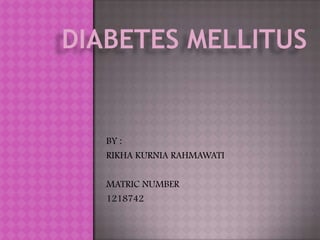
Diabetes mellitus
- 1. BY : RIKHA KURNIA RAHMAWATI MATRIC NUMBER 1218742
- 2. DEFINITION TYPES CAUSES SYMPTOMS COMPLICATIONS DIAGNOSIS RISK FACTORS
- 3. WHAT IS DIABETES MELLITUS? • Diabetes Mellitus can be called simply as diabetes • DIABETES = dia+bainein “to go through” or “excessive discharge of urine” • MELLITUS = mell “honey-sweet” • A lifelong (chronic) metabolic disease in which there are high levels of sugar in the blood.
- 4. WHAT IS DIABETES MELLITUS? • Either because the pancreas does not produce enough insulin (insulin deficiency), or cells do not respond to the insulin that is produced (insulin resistance). • This high blood sugar produces the classical symptoms of polyuria (frequent urination), polydipsia (increased thirst) and polyphagia (increased hunger).
- 5. WHAT IS INSULIN? • Insulin is a hormone produced by the pancreas • It has a function to control the amount of blood sugar • It works by attaching to the insulin receptor in cell to influence the Glut-4 to transport glucose Go to the picture
- 7. WHAT HAPPEN WITH THE INSULIN WHEN SOMEONE SUFFER
- 8. TYPE OF DIABETES MELLITUS There are three types of Diabetes Mellitus: 1. Diabetes Mellitus Type 1 2. Diabetes Mellitus Type 2 3. Gestational Diabetes
- 9. Diabetes mellitus TYPE 1 • Type 1 diabetes mellitus is characterized by: loss of the insulin-producing beta cells of the islets of Langerhans in the pancreas. in which beta cell loss is a T-cell- mediated attack. leading to insulin deficiency. • The majority of type 1 diabetes is of the immune-mediated nature • Thus, can be further classified as immune- mediated or idiopathic.
- 10. Diabetes mellitus TYPE 1 • Type 1 diabetes can occur at any age, • But it is most often diagnosed in children, teens, or young adults. • In this disease, the body makes little or no insulin. • Daily injections of insulin are needed.
- 11. Diabetes Mellitus TYPE 2 • Type 2 diabetes mellitus is characterized by: insulin resistance, which may be combined with relatively reduced insulin secretion. The defective responsiveness of body tissues to insulin is believed to involve the insulin receptor.
- 12. Diabetes Mellitus TYPE 2 • Type 2 diabetes makes up most diabetes cases. • It most often occurs in adulthood. • However, because of high obesity rates, teens and young adults are now being diagnosed with it. • Many people with type 2 diabetes do not know they have it.
- 13. GESTATIONAL DIABETES • Gestational diabetes is high blood sugar that develops at any time during pregnancy in a woman who does not have diabetes. • GDM resembles type 2 diabetes in several respects, involving a combination of relatively inadequate insulin secretion and responsiveness.
- 14. • It occurs in about 2%–5% of all pregnancies and may improve or disappear after delivery. • Gestational diabetes is fully treatable, but requires careful medical supervision throughout the pregnancy. • About 20%–50% of affected women develop type 2 diabetes later in life.
- 15. What causes diabetes mellitus? The cause of diabetes depends on the type 1. Type 1 Diabetes: The cause of this diabetes is partly inherited, and then It is triggered by certain infections, (with some evidence pointing at Coxsackie B4 virus). A genetic element in individual susceptibility to some of these triggers has been traced to particular HLA genotypes.
- 16. 2. Type 2 Diabetes Usually, this Diabetes is due primarily to lifestyle factors and genetics. The following is a comprehensive list of other causes of diabetes type 2 Genetic defects of β-cell function Genetic defects in insulin processing or insulin action Exocrine pancreatic defects Endocrinopathies Infections Drugs
- 17. 3. Gestational Diabetes Increased level of certain hormones made in placenta during pregnancy
- 18. High blood sugar levels can cause several symptoms, including: Blurry vision Excess thirst Fatigue Hunger Urinating often Weight loss
- 20. COMPLICATIONS After many years, diabetes can lead to other serious problems, the major long-term complications relate to Damage blood vessels cardiovascular disease The main "macro vascular" diseases atherosclerosis of larger arteries ischemic heart disease (angina and myocardial infarction), stroke and peripheral vascular disease. damages the capillaries microangiopathy. Diabetic retinopathy, which affects blood vessel formation in the retina of the eye visual symptoms, reduced vision, blindness
- 21. Other COMPLICATIONS Diabetic nephropathy, scarring changes in the kidney tissue, loss of small or progressively larger amounts of protein in the urine chronic kidney disease. Diabetic neuropathy numbness, tingling and pain in the feet skin damage (due to altered sensation) Together with vascular disease in the legs, neuropathy diabetes-related foot problems (such as diabetic foot ulcers) difficult to treat require amputation.
- 22. Diabetes mellitus is characterized by recurrent or persistent hyperglycaemia, and is diagnosed by demonstrating any one of the following: Fasting plasma glucose level ≥ 7.0 mmol/l (126 mg/dl) Plasma glucose ≥ 11.1 mmol/l (200 mg/dL) two hours after a 75 g oral glucose load as in a glucose tolerance test Symptoms of hyperglycaemia and casual
- 23. Risk of diabetes typically increase when you are: Older age (45 years or older) Less active (sedentary life) Overweight or obese Family history of diabetes Pacific Islander, Asian, African, Hispanic, Native American ancestry Pre-diabetes High blood pressure High lipids (triglycerides and low HDL) Diabetes during pregnancy or baby >9 lbs.
- 24. THANK YOU…
